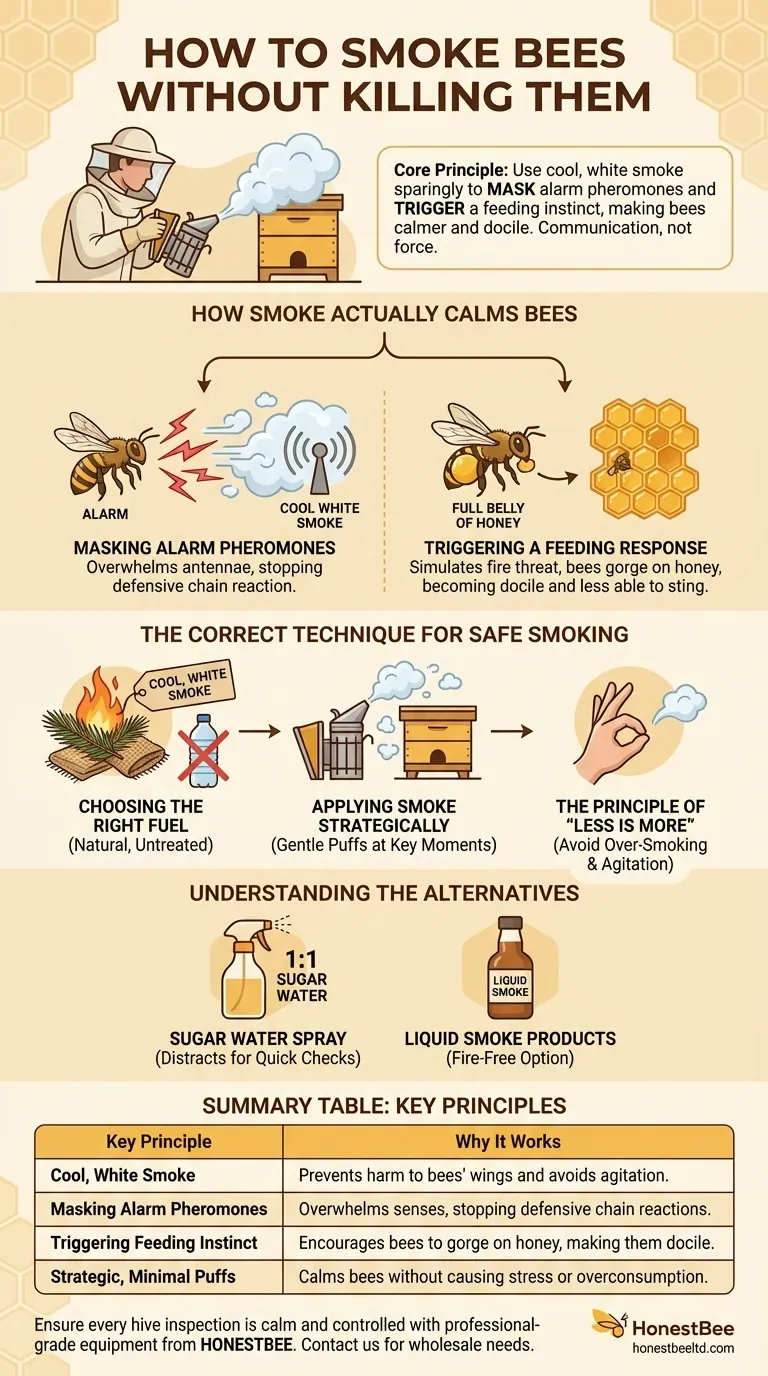To smoke bees without killing them, you must use a dedicated bee smoker with cool, white smoke and apply it sparingly. The goal is not to inundate the hive but to gently interrupt the bees' defensive communication by masking their alarm pheromones and triggering a natural feeding instinct, which makes them significantly calmer.
The core principle is communication, not force. Effective smoking calms bees by masking their alarm signals and making them focus on consuming honey, which renders them more docile and less likely to sting.

How Smoke Actually Calms Bees
Understanding the science behind smoking is the first step to using it correctly. The smoke has two primary effects on a honeybee colony.
Masking Alarm Pheromones
When a bee feels threatened or stings, it releases an alarm pheromone. This chemical signal, which smells a bit like bananas, instantly alerts other guard bees to a potential threat, triggering a coordinated defensive response.
The thick smoke from a smoker effectively masks these chemical signals. It overwhelms the bees' sensitive antennae, preventing the alarm from spreading throughout the hive and stopping a defensive chain reaction before it starts.
Triggering a Feeding Response
On a primal level, smoke signals a potential forest fire. The colony's instinctual response is to prepare to abandon the hive and find a new home.
To prepare for this journey, the bees immediately begin to gorge on honey. A bee with a full abdomen of honey is physically less able to curl its body to sting. This distraction, combined with a full belly, results in a much more docile and manageable colony.
The Correct Technique for Safe Smoking
Proper technique is what separates a calm inspection from a chaotic one. It ensures the bees are not harmed or overly stressed.
Choosing the Right Fuel
The key is to produce cool, white smoke, not hot, grey smoke. Hot smoke can burn the bees' delicate wings and cause them harm.
Good fuel sources are natural, untreated, and burn slowly. Excellent options include dry pine needles, untreated burlap, cotton fabric, or commercially available smoker pellets. Never use accelerants or plastics.
Applying Smoke Strategically
Application is about gentle puffs at key moments. Think of it as knocking on the door before entering.
- Puff a few gentle clouds of smoke at the hive entrance. Wait 30-60 seconds.
- Crack the outer cover and puff a little smoke into the opening.
- Slowly remove the inner cover, wafting a bit more smoke across the top frames.
- Pause and observe. Use additional small puffs only when the bees begin to get agitated or fly up at you.
The Principle of "Less is More"
Over-smoking is a common mistake that can be counterproductive. It can agitate the bees, make them consume too much honey, or even cause them to flee the hive (abscond). A few well-timed puffs are far more effective than continuous clouds of smoke.
Understanding the Alternatives
While smoking is a standard and effective practice, it is not the only option for calming bees.
When to Avoid Smoking
If you have an exceptionally docile colony, you may not need smoke at all for a quick inspection. A light mist of sugar water can be sufficient to distract them.
Common Smoker-Free Options
For beekeepers who wish to avoid smoke entirely, there are alternatives. A spray bottle with 1:1 sugar water can work by encouraging the bees' grooming and feeding behavior. Some also use sprays with essential oils like lemongrass, though their effectiveness can vary.
Making the Right Choice for Your Hive
Choosing the correct method depends on your colony's temperament and the task at hand.
- If your primary focus is a full, routine hive inspection: A properly managed smoker with cool smoke is the most reliable and effective tool.
- If your primary focus is a very quick check on a calm hive: A simple spray of sugar water is often sufficient and less disruptive.
- If your primary focus is avoiding fire risk entirely: Consider liquid smoke products, which can be sprayed at the entrance and under the lid.
Using a smoker correctly is a foundational skill that demonstrates respect for the bees and builds your confidence as a beekeeper.
Summary Table:
| Key Principle | Why It Works |
|---|---|
| Cool, White Smoke | Prevents harm to bees' wings and avoids agitation. |
| Masking Alarm Pheromones | Overwhelms bees' senses, stopping defensive chain reactions. |
| Triggering Feeding Instinct | Encourages bees to gorge on honey, making them docile. |
| Strategic, Minimal Puffs | Calms bees without causing stress or overconsumption of honey. |
Ensure every hive inspection is calm and controlled with professional-grade equipment from HONESTBEE.
As a trusted wholesale supplier for commercial apiaries and beekeeping equipment distributors, we provide the reliable, high-quality smokers and fuel you need to practice gentle bee management effectively. Our products are designed for durability and performance, helping you maintain hive health and productivity.
Ready to equip your operation with the best? Contact HONESTBEE today to discuss your wholesale needs and discover how our supplies can support your success.
Visual Guide

Related Products
- European Stainless Steel Bee Smoker for Honey Bee Hive
- Economy Galvanized Beekeeping Honey Bee Smoker for Wholesale
- Stainless Steel Honey Bee Smoker Hive and Honeycomb Smoker for Beekeeping
- Professional Bee Smoker with Elongated Spout and Durable Bellows for Beekeeping
- Premium Traditional Copper Bee Smoker with Bellows
People Also Ask
- What factors should be considered when choosing a bee smoker? Find the Right Tool for Safe, Effective Hive Management
- What are the features of a recommended bee smoker? A Guide to Safety, Durability & Performance
- What are the differences between stainless steel and galvanized steel bee smokers? Choose the Right Smoker for Your Apiary
- What are the benefits of smoking bees? Achieve Safer, Calmer Hive Inspections
- Can you use too much smoke on bees? The Right Way to Use a Bee Smoker for Calm Inspections



















